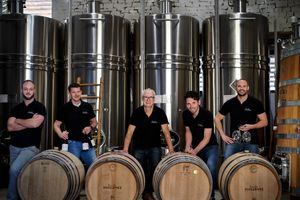
Travel with us to Burgundy
Welcome to our affordable Burgundy blog where we take you along in our quest and unravel the secrets of the lesser-known corners of Burgundy. We: Christopher, Avital and son Valentin have lived near Cluny, Mâcon, Pouilly-Fuissé, Saint-Véran for a number of years with our Chambres d'hôtes Maison Mazille and would like to share our finds with you.
Bourgogne-Franche-Comté is definitely at the top of the list when it comes to iconic regions in France. It is an enchanting place full of picturesque wine villages, ancient towns and unspoilt natural beauty. Follow us to the cradle of ''Cool Climate'' and ''Terroir''. Experience the interplay of the soil, climate, location and the magical hands of a winegrower. Smell the sun-warmed earth and stones in the vineyards and the scents released after a downpour on the hot asphalt of an idyllic winding road.
Step into the heart of France, where Burgundy is not only heaven for wine lovers, but also a paradise for holidaymakers. This enchanting region stretches from lively Dijon in the north to sunny Mâcon in the south, where the landscape slowly transforms into the enchanting world of Beaujolais. Winding between the iconic towns of Beaune and Mâcon, in the beloved department of Saône-et-Loire, the famous Autoroute du Soleil is as beloved as it is infamous among travelers. It is also the ideal stopover towards the south.
A stopover in Burgundy on your journey south is definitely a must. Be enchanted by the Burgundian French cuisine and taste the delicious wines that this region has to offer. Fortunately, you don't necessarily have to travel to enjoy all the beauty that Burgundy has to offer. At Burgundy or Nowhere we have a selection of delicious affordable Burgundy wines that you should not miss. Buying Burgundy wine is as easy as a click of your mouse - you can easily order your favorites online and have them delivered to your home.
Every season we hope to present a new domain that creates a special emotion. Smaller domains are taking the place of big household names and expensive chateaus. We don't settle for average flavors. We select Burgundies without pretensions, but which can feel high in quality without having to pay too much for it. With a focus on immediately enjoyable, affordable and sustainable Burgundy wine from small wine growers.
Burgundy is not just wine, it is an experience, an attitude, a reflection of life! It reflects the diversity and complexity of the region, where every village, vineyard and winemaker has its own unique style and character. Burgundy wine is for people who appreciate quality, authenticity and elegance. It is for people who want to discover the nuances and subtleties of different terroirs and vintages. In good and bad years. It is for people who like to combine wine with French classics such as Boeuf Bourguignon, Oeufs and Meurette or simply enjoy it with a cheese board!
Taste the refreshing mineral acids that give a beautiful tension to the well-known roundness of the Chardonnay grape and lush aftertaste for which Burgundy is known!
Whether you prefer a light red wine or a Bourgogne Pinot Noir, or a particularly rich white Bourgogne Chardonnay or a sparkling and festive Crémant de Bourgogne, with us you will find a wine that suits your taste and occasion.
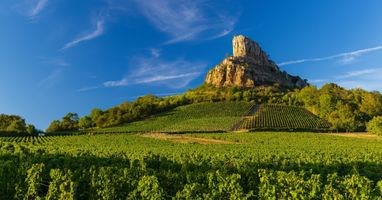
What do we want from Burgundy?
For us, emotion per euro is at the top of our checklist with a conscious price ceiling where we think the most value for money can be found.
Whether you are looking for a silky-soft Burgundy Pinot Noir that dances over the tongue or a complex Chardonnay with a backbone, Burgundy or Nowhere is the right place for you!
Elegance above all, but of course we also look for other styles within Burgundy because everyone's taste is different. The use of wood should never drown out, but only support. Now we are absolutely not averse to a good lick of vanilla in the nose or a touch of butter in the finale, provided it can be supported by sufficient mineral acids and other qualities that can create tension.
The last element in particular is where other wines often miss the mark by trying to appear bigger with excessive use of wood that can be presented in a segmented manner and has no connection at all with the rest of the wine and the story.
In addition, minerality is the most beautiful form of freshness to a buttery Burgundy. Finding the ultimate balance between these elements is the greatest challenge I know. I can't repeat it often enough, balance balance balance!
So the power of a good Burgundy wine is where all the flavors tell a story in harmony. And with sufficient oxygen in the glass or with age on the bottle, it can also tell different stories and which in turn can also be translated in several ways. The length of a good Burgundy is measured by how long the taste remains in balance. There are plenty of wines with lots of vanilla-like wood flavor notes towards the finale where the attack tells a completely different story. At first this seems like a special wine with diverse flavors, but that also makes the wine tiring in the long run. The extent to which a creamy Chardonnay is balanced from start to finish with refreshing fruity acidity means that the wine will never be boring. That is the real art of a good Burgundy wine!
Most of our range carries the HVE, BIO, DEMETER quality mark. We are not specifically looking for organic wine, but we do notice that the liveliness of ORGANIC wine scores much higher than non-organically produced wine. HVE, Haute Valeur Environnementale emphasizes various sustainability aspects, with an emphasis on promoting biodiversity in vineyards. The HVE logo on a wine bottle does not automatically indicate that it is organic wine, unless the wine is actually certified organic. Nevertheless, the logo signals the winegrower's commitment to sustainable vineyard management.
In organic and biodynamic (DEMETER) viticulture, chemical pesticides and fertilizers are prohibited, which is not only more environmentally friendly, but also promotes the quality and vitality of both the vine and the soil. Organic viticulture, with traditional craftsmanship, results in wines of higher quality, more complexity and terroir expression. Biodynamic winegrowers integrate cosmic influences such as the position of the moon and stars, use special preparations as an alternative to fertilizers, and place even greater emphasis on biodiversity in the vineyard.
Did you come across something during your holiday in Burgundy, but it no longer fit in the car?! Don't hesitate to contact us and we may be able to include your finds in our range! Would you like to learn more about Burgundy or Champagne? Then visit one of the bimonthly tastings. Follow us on socials for the announcement.
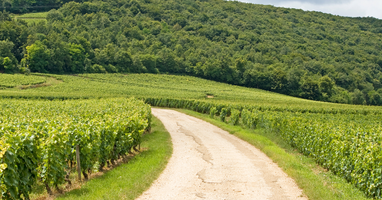
The re-emergence of Saint-Véran
Saint-Véran is vaak een vertrouwde keuze op de wijnkaart in de betere restaurants, maar waarom is dat eigenlijk?
Saint-Véran(d), diep gelegen in het zuiden van de Mâconnais, ongeveer 100 kilometer ten noorden van Lyon, is een dorp dat in 1971 zijn eigen Appellation d'Origine Contrôlée (AOC) kreeg. Dit gebied omringt de middeleeuwse burcht Chasselas en ligt onterecht in de schaduw van bekendere wijngebieden zoals Pouilly-Fuissé. Ondanks de bekende naam ligt het prachtig verscholen, ver van de grote weg. Hierdoor blijven Saint-Véran wijnen betaalbaarder en toch van hoge kwaliteit.
Kleine kanttekening is dat een overgroot deel in handen is van de Cave-Cooperative die er een zoetsappig en weinig spannend verhaal van hebben weten te maken. Echter, deze contracten lopen her en der langzaam af en zien de wijnboeren de potentie weer in van het terroir waar dit vandaag de dag een verlengstuk is van de mineraliteit van Pouilly-Fuissé met een geheel eigen karakter. Zodoende is er nu weer een nieuwe stroming van mega spannende Chardonnays die met trots Saint-Veran op hun etiket mogen dragen. Domaine de la Chapelle (Pouilly) en Clos Sauvage (Leynes) zijn hier de meest actuele voorbeelden van.
Saint-Véran produceert uitsluitend witte wijnen van de Chardonnay-druif. Er zijn twee hoofdtypes:
Houtgerijpte wijnen: Volle, ronde, sappige Chardonnays met een rijke, getoaste en licht boterige smaak.
Niet-Houtgerijpte wijnen: Vaak op staal opgevoed. Lichtere wijnen, maar nog steeds zacht en rond dankzij de zandsteenbodem en het iets warmere klimaat. Hierbij een focus op het terroir en fruit. De meest pure expressie maar dan zonder het verleidelijke botertje in de finale.
Located in the Mâconnais, about 100 kilometers north of Lyon, Saint-Véran(d) is a village that offers a unique wine experience. In 1971, this picturesque village was given its own Appellation d'Origine Contrôlée (AOC), Saint-Véran, which extends over 650 hectares of vineyards. This area surrounds the medieval castle of Chasselas and is unfairly in the shadow of better-known wine regions such as Pouilly-Fuissé. Despite the well-known name, it is beautifully hidden away from the main road. This means that Saint-Véran wines remain more affordable yet of high quality.
A small side note is that a large part is in the hands of the Cave Cooperative, who have managed to turn it into a sappy and not very exciting story. However, these contracts are slowly expiring here and there and the winegrowers are once again seeing the potential of the terroir, which today is an extension of the minerality of Pouilly-Fuissé with its own unique character. There is now a new wave of mega exciting Chardonnays that can proudly carry Saint-Veran on their label. Domaine de la Chapelle (Pouilly) and Clos Sauvage (Leynes) are the most current examples of this.
Saint-Véran produces exclusively white wines from the Chardonnay grape. There are two main types:
Barrel-aged Wines: Full, round and heavy Chardonnays with a rich, woody flavor.
Non-Wood-Aged Wines: Lighter wines, but still soft and round thanks to the sandstone soil and slightly warmer climate.
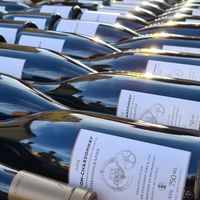
Watches & Wines
Our first discovery was made during the Grands Jours de Bourgogne in Beaune, a biennial wine fair for wine professionals. It immediately struck us that we were dealing with something special here.
Domaine Vuillemez embraces the adage of 'it is better to do a few things very well than many things mediocrely'. Their wines are a celebration of craftsmanship, patience and the timeless beauty of Burgundy and set a new standard by creating serious Burgundies in an environment where they have never been seen before. And that at an extremely competitive price where you can easily pay double for an equivalent bottle of wine.
Less than one percent of all Chardonnay in Burgundy bears the prestigious name Mâcon-Chardonnay. With roots dating back to 1937, Mâcon-Chardonnay is a modest area of about 230 hectares in the northern part of Sud-Bourgogne, the Mâconnais.
Domaine Vuillemez, a name steeped in watchmaking tradition, is a tribute to craftsmanship and passion in the world of Burgundy wine. Set amid the enchanting Burgundian landscapes and rolling hills of the Mâconnais, the members of the Vuillemez family have transferred their precision and dedication to perfection from watches to wine, creating a range of refined Chardonnay white wines that both - as wine lovers should delight.
In an ode to innovation and tradition, we find Domaine Vuillemez housed in an old barn in the heart of the village of Chardonnay, surrounded by centuries-old history. Here they experiment with bold choices, such as the use of egg-shaped concrete barrels alongside stainless steel and oak, giving their wines a unique character within the traditional Burgundian environment.
Claude Vuillemez's vision is continued by his sons Valentin and Paul, who inherited the art of precision from watchmaking and applied it to the winery. Called "vins watchers", they strive for nothing less than perfection, embracing the cult of slowness and taking the time to achieve greatness, both in their wines and in life itself.
Since 2007, Domaine Vuillemez has been committed to understanding the terroir and pursuing sustainability, aided by local experts such as Florent Barday and Swiss biodynamic specialist Christian Vessaz. By renewing more than half of their plantings between 2014 and 2021 and embracing natural methods, they strive for the pure expression of the fruit and the authentic character of their clean wines.
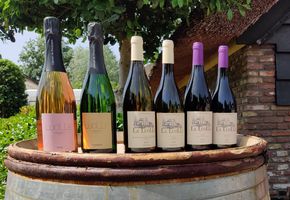
Crémant de Bourgogne
Looking for the perfect aperitif! For this we have to go to Olivier and Sandrine! We take you to Moroges by taking an exit just before we enter Givry.
Crémant de Bourgogne from the Côte Chalonnaise from Domaine de La Luolle.
Take your Burgundian experience to the next level with Crémant de Bourgogne from the Côte Chalonnaise, a sparkling wine made using traditional methods. Often overshadowed by its better-known counterparts from Champagne, Crémant de Bourgogne from this region combines quality and affordability. Discover our selection of sparkling wine secrets and enjoy an affordable alternative for sparkling wine lovers.
As you peruse our Crémant de Bourgogne collection, you will discover the sparkling secrets of the Côte Chalonnaise. Crafted with precision and finesse, these sparkling wines provide a festive touch without the premium price tag. Each bottle offers a glimpse into the vibrant side of Burgundy and showcases its versatility beyond still wines.
Domaine de la Luolle has something for everyone these holidays. While many wineries treat their Crémant merely as a by-product to offer a wide range for importers, a select group such as Domaine de la Luolle takes a different approach and makes it their calling card. This upside-down mindset will make you wonder why you ever settled for less by spending more.
The organic Demeter-certified millésime Crémant de Bourgognes from Domaine Luolle are invigorating and delicious sparkling wines from the Côte Chalonnaise (Moroges, near Givry). The beautiful minimalist Art Deco labels complete the picture on the table, especially when served in classic open Champagne coupes from a bygone era.
1. For the adventurous: Try something wild! A sparkling red bubble of partly fruity Pinot Noir and a hint of earthy Gamay such as the 2020 Bourgogne Mousseux, Rouge Bulles that fits perfectly with sweet treats.
2. For everyone: enjoy a rich, almost-Champagne experience with the 2020 Crémant de Bourgogne, cuvee Classique. The juicy flavors of quince and brioche create a perfect synergy.
3. For the experts: The Blanc de Blancs variant will make many Champagne drinkers doubt why they sometimes pay 80 euros a bottle for chalk-dry Champagne. Both the 2018 and 2020 Blanc de Blancs Crémant de Bourgogne offer a solution for this with its delicate mousse and notes of white flowers, flint, citrus and quince. The Blanc de Blancs Crémant de Bourgogne is the most versatile and special option for every occasion and every wallet. Whether you're celebrating a milestone or enjoying time with friends, this sparkling wine is sure to impress.
The refreshing bubbles go well with fish dishes such as tuna sashimi, fried salmon and raw oysters with a squeeze of lemon. However, it's not just limited to seafood. It is also an excellent addition to a cheese board. Creamy white cheeses match perfectly with this Crémant de Bourgognes. Even slightly spicy goat's cheese combines well with this sparkling wine.

Where craft is the standard...
Guest Blog: Remco van Dijk, proprietor at Wijnboom Champagne.
My love for France has really grown since I started visiting there every month. The small quaint villages where craft is not a special word, but the standard. The vast majority act here with passion and craft honest products by hand!
In addition, the houses are in a perfect state of disrepair. The narrow winding roads, the refined sun that continues to follow you with love throughout the day. You can understand that the feeling of real freedom was invented here.
This also applies to the small village with the beautiful name: Chigny Les Roses. A small and cute village that is half way up the hill. One of those villages that grabs you and never lets go! In the village of Chigny Les Roses I found a winemaker who makes wine in such a way as if he came from another planet. Everything has been thought through in detail and nothing is left to chance.
Guest Blog: Remco van Dijk, proprietor at Wijnboom Champagne.
My love for France has really grown since I started visiting there every month. The small quaint villages where craft is not a special word, but the standard. The vast majority act here with passion and craft honest products by hand!
In addition, the houses are in a perfect state of disrepair. The narrow winding roads, the refined sun that continues to follow you with love throughout the day. You can understand that the feeling of real freedom was invented here.
This also applies to the small village with the beautiful name: Chigny Les Roses. A small and cute village that is half way up the hill. One of those villages that grabs you and never lets go! In the village of Chigny Les Roses I found a winemaker who makes wine in such a way as if he came from another planet. Everything has been thought through in detail and nothing is left to chance.

A Secret Garden
A visit to Domaine Houblin-Vernin in the Grand-Auxerrois in the secret garden of the Parisians.
The northern part of Burgundy, excluding Chablis, is surrounded by the Grand Auxerrois and can be reached within two hours from Paris.
This area is home to numerous small, centuries-old vineyards that produce a diverse range of wines including white, rosé, red, "grey" and sparkling crémant. The vineyards are located along the chalky banks of the Armançon and the Yonne, where for centuries the wines produced were transported by water to Paris.
Several sub-regions are distinguished within the Grand Auxerrois:
Auxerrois: located immediately south and southwest of Auxerre, consisting of about ten municipalities.
Jovinien: around Joigny, the northernmost part of Burgundy for AOC wines.
Tonnerois: around Tonnerre.
Vézelien: around Vézelay.
As elsewhere in Burgundy, Pinot Noir and Chardonnay are dominant in the Grand Auxerrois. Other grape varieties grown include Aligoté, Sauvignon and Sauvignon Gris for white wines. Especially in Saint-Bris, wine growers also produce Sauvignon grapes. Sometimes Sacy or Melon grapes are used for white wines.
The César grape was brought to the Yonne by the Roman legions and produces very dark grapes with lots of tannins and red fruit aromas. It is sometimes used in certain wines from Irancy.
We're heading towards Migé. This is located in the lesser-known Burgundy region of Yonne and is part of the Bourgogne Coulanges-la-Vineuse appellation, in addition to neighboring villages within the Grand-Auxerrois. Initially under the broader appellation Burgundy, Migé gained recognition in 1993 with its own appellation, focusing mainly on red wines, but also on the production of white and rosé wines.
Here we visit Domaine Houblin-Vernin which has grown steadily over the years, moving from equal production of white and red wine to a focus on predominantly red wine. The estate specializes in Bourgogne Coulanges-la-Vineuse wines and offers five different cuvées, which differ mainly in the use of oak.
Migé's unique terroir, characterized by deeper clay-rich soils with lots of stones, contributes to the wines' distinct mineral qualities. This distinction is especially notable in white wines, where the Migé terroir comes to the fore, as noted by Jean-Luc Houblin. But not as mineral as Chablis, just a bit friendlier.
AOC Bourgogne Coulanges-la-Vineuse is located 15 km south of Auxerre and is the only regional appellation (with complementary appellation) on the left bank of the Yonne river. The Burgundian wine list features a varied landscape of vineyards, spread from north to south over no fewer than seven municipalities: Coulanges-la-Vineuse, Escolives-Sainte-Camille, Jussy, Migé, Mouffy, Charentenay and Val-de-Mercy. These vineyards surround small valleys formed by erosion and are located at altitudes ranging from 155 to 310 meters above sea level, benefiting from a favorable microclimate. The finest plots are often situated on slopes facing south and south-east. The subsoil consists mainly of limestone, clay and marl from the Kimmeridgian period. About 150 million years ago, and also known as the Late Jurassic Period, the deposition of sediment resulted in a soil rich in the aforementioned.
Despite historical challenges, including the devastation caused by phylloxera and the upheavals of two world wars, the Coulangeois area is experiencing a winemaking revival. The combined efforts of local winegrowers aim to increase the reputation of Bourgogne Coulanges-la-Vineuse beyond the Yonne region.
Efforts are underway to elevate Coulanges-la-Vineuse to a village appellation, which would impose stricter regulations and possibly lower yields. While some concerns remain among vintners about potential financial implications, this move marks a step toward increasing the prestige and market value of the appellation.

White Burgundy wine and white asparagus
An iconic combination.
The combination of wine with asparagus, both white and green, requires specific wine characteristics to create a harmonious taste experience. The most important components of a wine that ensure a good combination with asparagus are the acidity, the flavor profile, and the body of the wine.
1. **Acidity**: Asparagus, especially white ones, have a subtle and delicate flavor with a slight bitterness. A wine with good acidity can balance this bitterness and emphasize the freshness of the asparagus. Wines with high acidity, such as Sauvignon Blanc, Riesling, or a young Chardonnay, are often excellent choices.
2. **Taste Profile**: The flavor profile of the wine should be complementary to the earthy and slightly bitter notes of the asparagus. Wines with citrus and green apple notes pair well with green asparagus, while wines with buttery and nutty notes, such as some Burgundy wines, pair perfectly with white asparagus.
3. **Body**: The body of the wine also plays a role in the combination. Light to medium bodied wines work best because they don't drown out the delicate flavors of asparagus. Heavier wines can be too dominant and overshadow the subtle nuances of the asparagus.
White Burgundy wine and white asparagus together form a great combination in the culinary world. White Burgundy wine, from the Burgundy region of France, is made from the Chardonnay grape. These wines are known for their finesse and complexity, with flavor profiles ranging from fresh and fruity to rich and buttery, often with hints of citrus, green apple, hazelnut and sometimes a hint of vanilla from the wood aging. Now the southernmost Maconnais area is also known for its characteristic bitterness in the final, which fits in perfectly with the earthiness of the asparagus discussed earlier.
White asparagus, also known as "white gold," is a delicacy that is mainly marketed in the spring. They are grown underground, so they retain their characteristic pale color. White asparagus has a mild, delicate flavor with a slight bitterness and a refined texture.
When white Burgundy wine is combined with white asparagus, a harmony of flavors is created. The acidity and freshness of the wine perfectly complement the soft and subtle flavors of the asparagus. This classic duo is often served with a simple sauce, such as Hollandaise or melted butter, which brings out the flavors of both the wine and the asparagus.
In summary, a wine that pairs well with asparagus should have refreshing acidity, a complementary flavor profile, and a light to medium body. These properties ensure that both the wine and the asparagus come into their own, without dominating each other.
Good acidity is especially important with green asparagus. Green asparagus has a fresh, sometimes bitter taste that can be well balanced by the refreshing acidity of the wine. Wines such as Sauvignon Blanc, Pinot Grigio, and Grüner Veltliner are known for their high acidity and work great to accentuate and freshen the earthy notes of the asparagus. But people often forget that Burgundy wine also has great mineral freshness. These are often the wines without wood aging and therefore come from steel or concrete tanks. Minerality is a valuable property. Wines with a slight minerality, often found in wines from cooler climates or specific terroirs such as the Loire Valley and in our case, Burgundy, can emphasize and enhance the earthy characteristics of the asparagus, creating a more layered and interesting tasting experience.
In addition, the fruitiness of the wine plays a crucial role. Wines with vibrant fruity notes, such as citrus, green apple or pear, can complement and harmonize the green flavors of the asparagus. These fruity nuances help to balance the bitter notes of the asparagus and add a refreshing dimension to the meal.
Our recommendations can be found in the menu under the heading ''Asparagus''. But if we can make a suggestion, it would be the watch wines from Domaine Vuillemez described below. With green asparagus you take the ''Tourbillion'' cuvee which has rested on concrete and presents lots of green fruit and with the white asparagus you serve the slightly buttery but also mineral ''Les Beluses'' cuvee.

